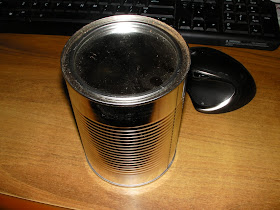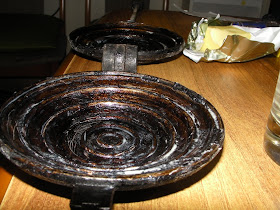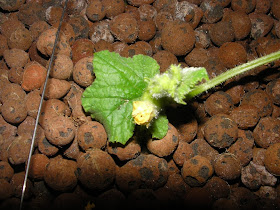As far as I can tell, everything worth eating, is worth smoke curing.

As a result of a gift from my other mother, we have one of these in our yard.
Shiny!
And poorly photographed!
"Poorly photographed", is a new style I'm exploring a bit in this post.
A gas BBQ is all well and good, but as part of the move to gas, we tend to miss out a bit on the flavours that woodsmoke can provide.
Gas = good
Wood = good
Gas AND woodsmoke = amazing!
An extremely important part of this "Thing" is the humble tin can. I say humble, but I'm not really sure if a tin can actually does humble.
I'm guessing a tin can mostly does tin can things.
Lurking springs to mind.
Shinning might also rate a mention if it's a fresh one.
Mine's a fresh one.
Shine can, shine.
Lurk can, lurk.
A tin can can also have holes punched through it with an old mini-screwdriver, but I'll get to that a bit later.
For now, I'll introduce the backbone and or possibly un-necessary briquette.
Backbone, because it provides the heat that drives the smoke.
Un-necessary, because it might not.
I cant really tell what contribution this stuff made, other than it was used, and the result was good.
I also don't know enough to endorse any product you might see in this post, so take everything I say as you always should, with a grain of bacon salt.
Now is probably a good time to say that none of this stuff is my idea or anything (except perhaps using a screwdriver as a drill, and then enlarging those screwdriver holes with a bigger, thicker screwdriver ) but rather, it's a collage of everything I've read over the last few days, and the implementation is based on trial and error in real time, bizarre ritual, and risking tonight's meal.
DO try this at home. (except maybe the bit about ramming a screwdriver through a can of burning coal)
Anyway...
The briquettes look like this up close.
They look like brown coal, but I suspect they are made of more recent trees. Checking...
Ok... well it seems the packaging reads "Not suitable for barbecues. Probably something I should have read before buying it. Perhaps it shouldn't have been displayed in the BBQ section of the hardware I bought them from.
You live and learn.
I hope this isn't what made today's smoking such a success.
I have no idea what's in these things, so please don't use them unless you find out, and then please tell me what they are made off so I can seek whatever medical attention I might need.
I'm sure I'll be walrus.
Anyway...
other things to show and tell, include hickory chips.
I ended up using around two cups for my two chicken thighs, but I'm guessing it would make no difference how much stuff I put in the BBQ. It would still take around two cups.
Two chicken thighs in a BBQ is a total waste of energy, but I didn't want to waste too much food if it all went wrong.
I also bought some fire starter cube things to get the briquettes that are unsuitable for BBQs alight.
I have no idea what these things are made of.
If I ran an unscrupulous country that wanted to get rid of it's toxic waste, I'd just shape it into things and export it as products.
Outdoor furniture and so forth.
So, I smacked a few holes in my tin can with a rusty old mini-screwdriver thing.
I knew it was sharp enough for this task, because every other time I use it for a task it wasn't designed for, I manage to gain a body piercing of a part of my hand that was never designed to receive such a thing.
This time I hurt nothing but the can, because it turns out cans are pretty thin.
Confident stabs make smaller dents in the can, and cleaner holes.
Stab confidently.
I punched two extra holes at the top to thread a loop of wire through to act as a handle.
Probably not required, but I did use it at the end of the day to pick it up and put it under a water tap to make sure any leftover fire was safely out.
So... add a handle if you have a handy coat hanger or length of wire.
Pliers also work as a handle.
It took way too long to get the briquettes going because there was clearly not enough oxygen getting to them.
The flames were there, but they started at the top where they met fresh air rather than at the fuel where a fire should be.
So I "extra safely" punched a few more holes through, then made them bigger with a thicker screwdriver.
It turns out it's probably not a good idea to do this when it's burning, but it worked out fine in the end.
The fire took on a much more healthy glow, and I held back on adding too many holes to the lid, because I figured I might need to damp the fire down a bit because I want smoke not flame.
You cant really see it in the pic, but the flame actually looked like it was coming in through the holes at the bottom. Like an inside out gas burner. Like the fuel was gasing, and the flames did what they did to seek the oxygen.
Interesting. And a pretty handy tin can stove.
To be honest, I don't really understand why this was burning like I wanted it to when I wanted to get it alight, but then settled down to what I wanted it to do when I wanted smoke.
All the photos above include flame from the fire starter things, so perhaps it's just a case of them burning with a bit more gusto than the heat beads and wood chips.
Or it could be the water soaking of the wood chips.
Did I mention that? The wood chips were soaked in water boiling water for a few minutes before being added to the tin can with the glowing briquettes.
I suspect they dry out before they start to smoke, so perhaps it's just to stage the wood chips so they don't all go up in flames at the same time. As far as I can tell, it should be possible to either make them burn in stages by wetting them, creating only a small section at any one time that's dry enough and hot enough to start smoking, OR restrict the airflow and choke them to whatever combustion rate you want.
Perhaps the water soaking has some other reason. I'll let you know if it turns out to be important.
Smoke!
Lots of it.
I didn't push the number of holes, because I didn't want it to go to flame, but I got the feeling I could have made as much smoke as I wanted simply by adding more.
There was quite a bit of slack space between it burning , and it smoking. If I put out the fire, it would take a lot of blowing at the holes around the bottom to get it to flame again. (I only did this to test how forgiving it was) The result was that it seemed to prefer to make smoke rather than fire unless it was really coaxed into flame, and even then it settled back to making smoke.
Clearly it knew it's designated task.
I'll play a bit more later, and there's always the lid to damp it down if needs be. I might even add a second lid so I can turn it like a tap to adjust it. ie, a big hole in each lid, and overlap them so you can change the size of the hole.
I was concentrating on air in, but controlling air (or exhaust) out does the same thing. It probably doesn't matter which one you control, the result is, if you restrict the airflow over the coals, you restrict the burn, and control the smoke.
After an hour or so of smoke that was sometimes on and sometimes off, depending on what I was trying at the time, the result looked like this.
To be honest, I was a little disappointed.
I thought it would have a lot more smoke colour to it. Some of that colour on the bacon was there in the beginning. And this photo is actually a little flattering as far as colour goes.
But it was getting late so I lit the BBQ and brought the bacon wrapped, blue cheese, and tomato stuffed chicken thigh parcels (my best tying effort to date in my own opinion) up to an internal temperature of 75c.
Apparently I missed a step called brining. I'll let you know if it turns out to have been important. I think it involves marinating your food in a salt water solution before smoking like I had to do with the home made cheese "thing".
But the result was truly amazing!
Totally worthwhile.
My big fear is that this will be one of those beginners luck things, and that I will now spend the rest of my life trying to duplicate it.
Hopefully, and perhaps more likely, is that this is just the beginning of what is possible with smoking.
I hope so.
The result makes for a terrible photo, because for some reason, I went for an autopsy/science look rather than a food look.
Never take a food cross section photo straight on.
Originally I was a bit suspicious of the pink, thinking it might be under cooked, but my digital meat thermometer said it was cooked, and it turned out the thermometer knows it's stuff.
The chicken looked a bit like good bacon.
The bacon wrapped around the chicken looked like what I now call good chicken.
If anything it was actually a little over-done, but the brining step might add a bit of moisture to the final product that might counteract that.
Who knows. I cant wait to find out.
The only thing to do is learn a bit more, and do it again.
I rate this experiment with a tin can smoker a total success, and if you've ever thought about smoke curing stuff, I thoroughly recommend giving it a go.
Insanely delicious.
I hope the in(common)-laws don't read this and want their BBQ back.
120 Things in 20 years - Smoke cured stuff really rocks, and you can knock up a tin can smoker in only a few minutes.







































